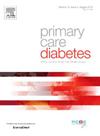Shoulder pain among type 2 diabetes mellitus patients: A cross-sectional study in Chilean population
IF 2.6
4区 医学
Q3 ENDOCRINOLOGY & METABOLISM
引用次数: 0
Abstract
Aim
This study aimed determine the prevalence of shoulder pain among Chilean patients with type 2 DM and to characterize their pain intensity and associated disabilities, including an analysis of sex-based differences.
Methods
A total of 151 participants with type 2 DM, aged 18–79, from family health centers in Talca, Chile, were included. Data were collected via telephone interview, capturing demographic details and information about current shoulder pain, including its duration, intensity, using a Numerical Rating Scale (NRS), and disability using the Shoulder Pain and Disability Index (SPADI). Statistical analysis was performed using frequency measures, Chi-squared tests, binary logistic regression, and Student's t-tests with SPSS version 21.0.
Results
Out of 1662 eligible patients, 151 participated. The overall prevalence of shoulder pain was 53.6 % (95 % CI: 53.8–53.4), with women showing a higher prevalence (63 %; 95 % CI: 63.2–62.8) compared to men (37 %; 95 % CI: 37.2–36.8), a difference that was statistically significant (chi-square=13.5; p ≤ 0.001). The results showed that neither BMI nor sex was significantly associated with the presence of pain. No significant differences were found between sexes regarding pain intensity and disability (p ≥ 0.05).
Conclusion
Shoulder pain is highly prevalent among patients with type 2 DM, with a higher prevalence in women. Future research should explore the impact of this condition on patients and develop targeted musculoskeletal rehabilitation programs.
2型糖尿病患者肩痛:智利人群的横断面研究
目的:本研究旨在确定智利2型糖尿病患者肩痛的患病率,并表征他们的疼痛强度和相关残疾,包括基于性别的差异分析。方法:从智利Talca的家庭健康中心共纳入151名年龄在18-79岁的2型糖尿病患者。通过电话访谈收集数据,使用数字评定量表(NRS)获取有关当前肩痛的人口统计细节和信息,包括其持续时间、强度,使用肩痛和残疾指数(SPADI)获取残疾情况。统计分析采用频率测量、卡方检验、二元logistic回归和学生t检验,使用SPSS 21.0版本。结果:在1662例符合条件的患者中,151例参与了研究。肩部疼痛的总体患病率为53.6 %(95 % CI: 53.8-53.4),女性患病率更高(63 %;95 % CI: 63.2-62.8)与男性相比(37 %;95 % CI: 37.2-36.8),差异有统计学意义(卡方=13.5;p ≤ 0.001)。结果显示,身体质量指数和性别与疼痛的存在都没有显著的关系。在疼痛强度和残疾方面,性别间无显著差异(p ≥ 0.05)。结论:肩痛在2型糖尿病患者中非常普遍,女性患病率更高。未来的研究应该探索这种情况对患者的影响,并制定有针对性的肌肉骨骼康复计划。
本文章由计算机程序翻译,如有差异,请以英文原文为准。
求助全文
约1分钟内获得全文
求助全文
来源期刊

Primary Care Diabetes
ENDOCRINOLOGY & METABOLISM-PRIMARY HEALTH CARE
CiteScore
5.00
自引率
3.40%
发文量
134
审稿时长
47 days
期刊介绍:
The journal publishes original research articles and high quality reviews in the fields of clinical care, diabetes education, nutrition, health services, psychosocial research and epidemiology and other areas as far as is relevant for diabetology in a primary-care setting. The purpose of the journal is to encourage interdisciplinary research and discussion between all those who are involved in primary diabetes care on an international level. The Journal also publishes news and articles concerning the policies and activities of Primary Care Diabetes Europe and reflects the society''s aim of improving the care for people with diabetes mellitus within the primary-care setting.
 求助内容:
求助内容: 应助结果提醒方式:
应助结果提醒方式:


